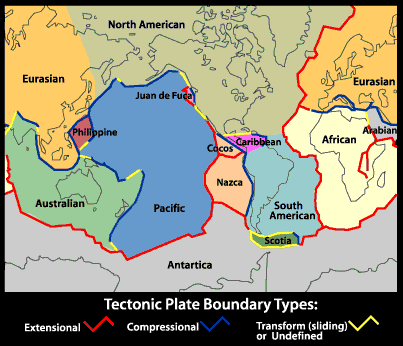|
The theory
of plate tectonics has done for geology what Charles Darwin's theory
of evolution did for biology. It provides geology with a comprehensive
theory that explains "how the Earth works." The theory
was formulated in the 1960s and 1970s as new information was obtained
about the nature of the ocean floor, Earth's ancient magnetism,
the distribution of volcanoes and earthquakes, the flow of heat
from Earth's interior, and the worldwide distribution of plant and
animal fossils.

The theory
states that Earth's outermost layer, the lithosphere, is broken
into 7 large, rigid pieces called plates: the African, North American,
South American, Eurasian, Australian, Antarctic, and Pacific plates.
Several minor plates also exist, including the Arabian, Nazca, and
Philippines plates.
The plates
are all moving in different directions and at different speeds (from
2 cm to 10 cm per year--about the speed at which your fingernails
grow) in relationship to each other. The plates are moving around
like cars in a demolition derby, which means they sometimes crash
together, pull apart, or sideswipe each other. The place where the
two plates meet is called a plate boundary. Boundaries have different
names depending on how the two plates are moving in relationship
to each other
With respect
to plate boundaries is your home located in the middle of, or near
the boundary of a plate? What does this mean for you tectonically?
Next
|











